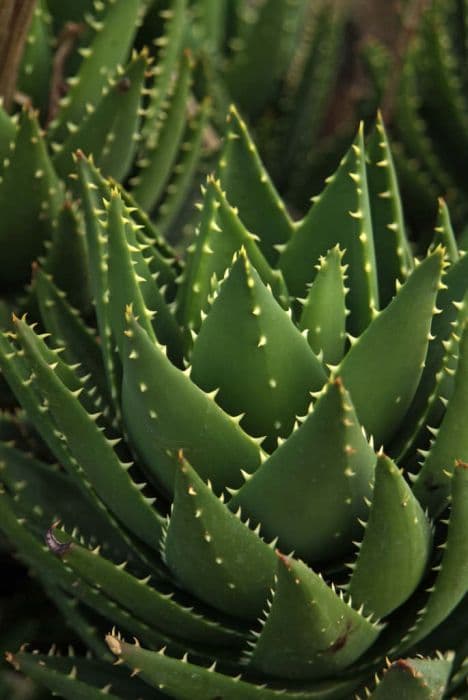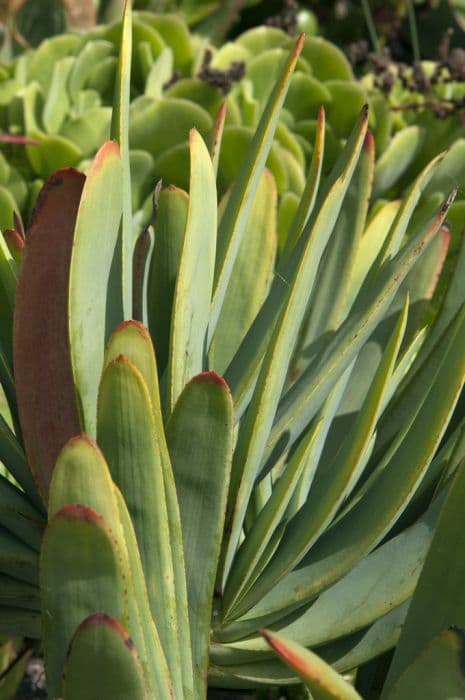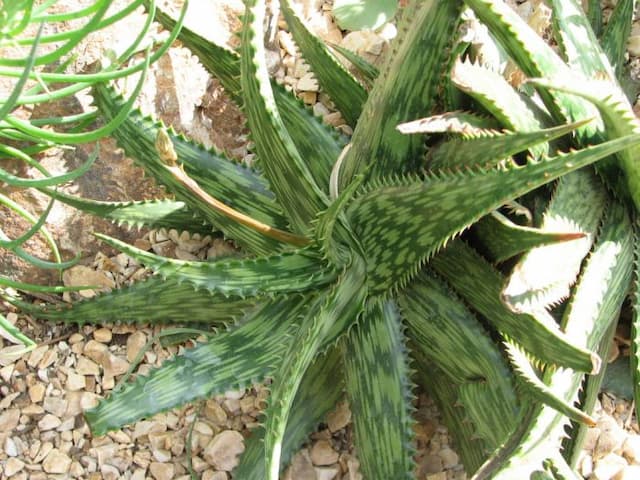Coral Aloe Aloe striata

ABOUT
Aloe striata, commonly known as Coral Aloe, is a striking and attractive plant characterized by its smooth, flat, broad leaves. The leaves of the Coral Aloe are a bluish-green color and can sometimes have a pinkish hue, especially around the edges, adding to its ornamental appeal. Unlike many other Aloe species, Coral Aloe leaves are distinctive because they lack the spines or teeth commonly found along the leaf margins. The edges of the leaves are usually lined with a reddish-pink color which matches the coral-tone of the flowers that the plant produces. The flowers of the Coral Aloe emerge on tall flower spikes and are tubular in shape, also exhibiting a vibrant coral-pink to orange color, making the plant a favorite among gardeners looking for a pop of color. The blooming period typically occurs in the cooler months, offering a cheerful display when other plants may not be flowering. The smooth, flat leaves, along with the strikingly colored leaf edges and vibrant flowers, give the Coral Aloe a unique and attractive appearance that stands out in succulent gardens or as a part of a drought-tolerant landscape.
About this plant
 Names
NamesFamily
Asphodelaceae.
Synonyms
Coral Aloe, Striate Aloe, Hard-leaved Aloe, Grass Aloe.
Common names
Aloe hanburyi, Aloe komaggasensis, Aloe striata var. caesia, Aloe striata var. komaggasensis, Aloe ubomboensis.
 Toxicity
ToxicityTo humans
Coral Aloe (Aloe striata) is generally not considered toxic to humans. However, as with many plants, it could cause mild irritation if ingested. Some people might have sensitive reactions to the gel inside the leaves, experiencing gastrointestinal disturbances like diarrhea or cramps.
To pets
While Coral Aloe is not highly toxic to pets, it can cause mild to moderate gastrointestinal upset if ingested. Symptoms in pets might include vomiting, diarrhea, lethargy, or loss of appetite. Cats and dogs are both at risk for these symptoms if they consume any part of the plant. Owners should monitor their pets and consult a veterinarian if symptoms are severe or prolonged.
 Characteristics
CharacteristicsLife cycle
Perennials
Foliage type
Evergreen
Color of leaves
Green
Flower color
Coral
Height
1-2 feet (0.3-0.6 meters)
Spread
1-2 feet (0.3-0.6 meters)
Plant type
Succulent
Hardiness zones
9
Native area
South Africa
Benefits
 General Benefits
General Benefits- Ease of Care: Aloe striata, commonly known as Coral Aloe, typically requires minimal maintenance and is quite drought-tolerant once established.
- Attractive Appearance: The Coral Aloe has a distinctive appearance with its smooth, flat leaves and striking coral-colored margins, which can add aesthetic value to any garden or home setting.
- Low Water Requirements: Suited to xeriscaping or water-wise gardens, Aloe striata is an ideal choice for areas with water restrictions or for gardeners seeking to reduce water use.
- Attracts Wildlife: The flowers of Coral Aloe can attract pollinators like bees, butterflies, and birds, helping to support local ecosystems.
- Frost Tolerance: While it prefers warm climates, Coral Aloe can tolerate light frosts, making it suitable for growth in a variety of climates.
- Soil Adaptability: It is adaptable to different soil types, provided they are well-draining, which means it can thrive in a range of garden settings.
- Pest Resistance: Aloe striata is relatively resistant to pests, reducing the need for chemical pesticides.
- Seasonal Interest: With its winter to spring blooming, Coral Aloe provides color and interest during times when many other plants may not be flowering.
 Medical Properties
Medical Properties- This plant is not used for medical purposes.
 Air-purifying Qualities
Air-purifying QualitiesThis plant is not specifically known for air purifying qualities.
 Other Uses
Other Uses- Aloe striata, commonly known as Coral Aloe, can be used in xeriscaping, a method of landscaping that reduces or eliminates the need for supplemental water from irrigation.
- Its colorful leaves and coral-red flowers make it an attractive ornamental plant in rock gardens and as a potted plant in patios and decks.
- The mucilaginous substance inside the leaves of Coral Aloe can be used as a natural adhesive in small-scale or emergency situations.
- The fleshy leaves of the Coral Aloe can be sliced and placed in refrigerator to provide a cool compress for heat relief on hot days.
- Dried leaves of the Coral Aloe plant are sometimes used in decorative arrangements or as part of a natural potpourri due to their interesting texture and shape.
- Fibers obtained from the leaves can be used in the crafting of small, natural cordage or twine for garden use or creative projects.
- The plant can be used in educational settings as a teaching tool to discuss water conservation, desert adaptation, and succulent care.
- Aloe striata's drought-resistant properties make it an ideal candidate for use in green roofing projects where low maintenance vegetation is required.
- During flowering, the plant can serve as a food source for pollinators like bees and hummingbirds, enhancing local biodiversity.
- The distinctive flat-leaved rosette formation of Coral Aloe can be used to provide aesthetic contrast in texture and form in landscape design alongside spikier plants.
Interesting Facts
 Feng Shui
Feng ShuiThe Coral Aloe is not used in Feng Shui practice.
 Zodiac Sign Compitability
Zodiac Sign CompitabilityThe Coral Aloe is not used in astrology practice.
 Plant Symbolism
Plant Symbolism- Healing and Protection: Aloe striata is commonly referred to as "Coral Aloe," and aloe plants in general have been used for medicinal purposes for centuries, symbolizing healing powers and physical protection.
- Beauty and Skin Care: Known for its soothing properties and benefits to skin health, Coral Aloe symbolizes beauty and the nurturing of skin.
- Resilience and Adaptation: Native to tough environments, Coral Aloe is adept at surviving in harsh conditions, representing resilience and the ability to adapt to challenges.
- Purification: The aloe plant is often associated with the purification of the air and spiritual cleansing.
- Good Luck: In some cultures, aloe plants are thought to bring good luck and ward off negative energies.
 Water
WaterCoral Aloe prefers infrequent but deep watering. Allow the soil to dry out completely between watering sessions to prevent overwatering and potential root rot. Typically, you can water this succulent every 2 to 3 weeks with about 8-16 ounces of water during the growing season. In winter, reduce watering to once a month or less, as the plant goes into dormancy. Always check the top inch of the soil for dryness before adding water.
 Light
LightCoral Aloe thrives in bright, indirect sunlight but can tolerate some direct sun. Ideal placement is in a spot where it receives morning light and shade during the peak intensity of the afternoon. Avoid full, harsh sunlight which can scorch the leaves, especially during the hottest part of the day.
 Temperature
TemperatureCoral Aloe prefers temperatures between 60 and 75 degrees Fahrenheit but can survive in temperatures as low as 40 degrees and as high as 80 degrees Fahrenheit. It is not frost-hardy, so if you live in a region with cold winters, it's essential to bring the plant indoors or protect it from freezing temperatures.
 Pruning
PruningCoral Aloe typically requires minimal pruning, mostly to remove any dead or damaged leaves and to maintain its appearance. The best time for pruning is in the spring or early summer before the growing season begins. Use clean, sharp scissors or pruning shears and cut close to the base without harming the plant's central rosette.
 Cleaning
CleaningAs needed
 Soil
SoilCoral Aloe requires well-draining soil with a pH around 7.0 to 8.0. A suitable mix might include equal parts of coarse sand, perlite, and potting soil to ensure good drainage and aeration, which is critical for the health of the plant's roots.
 Repotting
RepottingCoral Aloe, or Aloe striata, should be repotted every two to three years to refresh the soil and provide space for root growth. Choose a pot only slightly larger than the current one to prevent excess soil moisture retention.
 Humidity & Misting
Humidity & MistingCoral Aloe thrives in low humidity environments typical of its natural arid habitat. Aim for a humidity level that does not exceed 40% to mimic the conditions it grows best in.
 Suitable locations
Suitable locationsIndoor
Place Coral Aloe in bright light inside, away from drafts.
Outdoor
Plant Coral Aloe in full sun to partial shade, in sandy soil.
Hardiness zone
9-11 USDA
 Life cycle
Life cycleCoral aloe (Aloe striata) begins its life as a seed, often germinating after a rain event when conditions are warm and moist. Seedlings emerge with succulent leaves adapted to store water, enabling them to survive in arid conditions. As the coral aloe matures, it develops a rosette form with smooth, flat leaves edged with a distinctive red-pink coloration, which intensifies with sunlight exposure. This plant reaches maturity in a few years, at which point it produces tall flower spikes bearing tubular coral-colored flowers that attract pollinators. After flowering, seeds are produced and dispersed, continuing the life cycle. The parent plant may produce offsets or "pups" at its base, which can be detached and replanted to propagate new individuals, thus further contributing to the species' proliferation.
 Propogation
PropogationPropogation time
Spring-Early Summer
Aloe striata, commonly known as Coral Aloe, can be propagated most effectively through offsets, which are small plants that grow at the base of the parent plant. This method is popular due to its simplicity and high success rate. Once the offsets have formed a substantial root system, usually visible when they have developed several inches in size, they can be gently removed from the parent plant. This is typically done in spring or early summer to give the new plants a full growing season to establish themselves. Carefully separate the offsets from the main plant using a clean, sharp knife, ensuring that each offset has some roots attached. After removal, allow the offsets to sit in a warm, dry place for a few days to form a callous over the cut surface. This helps to prevent infection when planted in well-draining soil, ideally in a mixture formulated for succulents. After planting, water sparingly until the plant displays new growth, indicating that it has successfully taken root.









